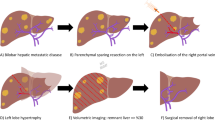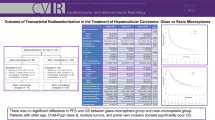Abstract
Objective
Image-guided high-dose-rate interstitial brachytherapy (iBT) with iridium-192 is an effective treatment option for patients with liver malignancies. Little is known about long-term radiation effects on the bile duct system when central hepatic structures are exposed to iBT. This retrospective analysis investigates the occurrence of posthepatic cholestasis (PHC) and associated complications in patients undergoing iBT.
Materials and methods
We identified patients who underwent iBT of hepatic malignancies and had point doses of ≥1 Gy to central bile duct structures. Patients with known bile duct-related diseases or prior bile duct manipulation were excluded.
Results
102 patients were retrospectively included. Twenty-two patients (22%) developed morphologic PHC after a median of 17 (3–54) months; 18 of them were treated using percutaneous transhepatic cholangiopancreatography drainage or endoscopic retrograde cholangiopancreatography. The median point dose was 24.8 (4.4–80) Gy in patients with PHC versus 14.2 (1.8–61.7) Gy in those without PHC (p = 0.028). A dose of 20.8 Gy (biological effective dose, BED3/10 = 165/64.1 Gy) was identified to be the optimal cutoff dose (p = 0.028; 59% sensitivity, 24% specificity). Abscess/cholangitis was more common in patients with PHC compared to those without (4 of 22 vs. 2 of 80; p = 0.029). Median survival did not differ between patients with and without PHC (43 vs. 36 months; p = 0.571).
Conclusion
iBT of liver malignancies located near the hilum can cause PHC when the central bile ducts are exposed to high point doses. Given the long latency and absence of impact of iBT-induced PHC on median survival, the rate of cholestasis and complications seen in our patients appears to be acceptable.
Zusammenfassung
Zielsetzung
Die bildgestützte interstitielle Hochdosis-Brachytherapie (iBT) mit Iridium-192 ist eine effektive Methode zur Ablation hepatischer Malignome. Unklar ist die Langzeitauswirkung auf das Gallengangsystem bei Bestrahlung zentraler Leberstrukturen. Die vorgestellte retrospektive Studie eruiert den Einfluss der iBT auf die Entstehung posthepatischer Cholestasen (PHC) und vergesellschafteter Komplikationen.
Material und Methoden
Eingeschlossen wurden Patienten mit iBT hepatischer/hilusnaher Malignome mit Punktdosen ≥1 Gy an zentralen Gallengangstrukturen. Ausschlusskriterien waren gallengangassoziierte Erkrankungen oder vorherige Manipulationen an den Gallenwegen.
Ergebnisse
In die Studie konnten 102 Patienten eingeschlossen werden. Von diesen entwickelten 22 (22 %) nach im Median 17 Monaten (Spanne 3–54 Monate) eine morphologische PHC, die in 18 Fällen (18 %) mit perkutaner transhepatischer Cholangiodrainage oder endoskopischer retrograder Cholangiopankreatikographie abgeleitet werden musste. Die Punktdosis der Patienten mit PHC lag im Median bei 24,8 Gy (Spanne 4,4–80 Gy), derjenigen ohne PHC bei 14,2 Gy (Spanne 1,8–61,7 Gy; p = 0,028). Bei 20,8 Gy (biologische effektive Dosis, BED3/10 = 165/64,1 Gy) konnte ein optimaler Cut-off-Wert (Schwellendosis) ermittelt werden (p = 0,028; Sensitivität 59 %, Spezifität 24 %). Abszesse/Cholangitiden traten bei Patienten mit PHC signifikant häufiger auf als ohne (4 von 22 vs. 2 von 80; p = 0,029). Im medianen Überleben zwischen Patienten mit und ohne PHC zeigte sich kein Unterschied (43 vs. 36 Monate; p = 0,571).
Schlussfolgerung
Die iBT hilusnaher Lebertumore kann bei hohen Punktdosen an zentralen Gallengängen zu einer klinisch relevanten PHC führen. In Anbetracht der langen Latenzzeit und der fehlenden Auswirkung iBT-assoziierter PHC auf das mediane Überleben halten wir die ermittelte Rate an Strikturen und Komplikationen für akzeptabel.




Similar content being viewed by others
References
Kuo I‑M, Huang S‑F, Chiang J‑M et al (2015) Clinical features and prognosis in hepatectomy for colorectal cancer with centrally located liver metastasis. World J Surg Oncol 13:92. https://doi.org/10.1186/s12957-015-0497-6
Schmoll HJ, Van Cutsem E, Stein A et al (2012) ESMO consensus guidelines for management of patients with colon and rectal cancer. A personalized approach to clinical decision making. Ann Oncol 23:2479–2516. https://doi.org/10.1093/annonc/mds236
Fukasawa M, Takano S, Shindo H et al (2017) Endoscopic biliary stenting for unresectable malignant hilar obstruction. Clin J Gastroenterol 10:485–490. https://doi.org/10.1007/s12328-017-0778-4
Cho Y, Kim TH, Seong J (2017) Improved oncologic outcome with chemoradiotherapy followed by surgery in unresectable intrahepatic cholangiocarcinoma. Strahlenther Onkol 193:620–629. https://doi.org/10.1007/s00066-017-1128-7
Kim Y, Rhim H, Cho OK et al (2006) Intrahepatic recurrence after percutaneous radiofrequency ablation of hepatocellular carcinoma: analysis of the pattern and risk factors. Eur J Radiol 59:432–441. https://doi.org/10.1016/j.ejrad.2006.03.007
Ohnishi T, Yasuda I, Nishigaki Y et al (2008) Intraductal chilled saline perfusion to prevent bile duct injury during percutaneous radiofrequency ablation for hepatocellular carcinoma. J Gastroenterol Hepatol 23:e410–e415. https://doi.org/10.1111/j.1440-1746.2007.05091.x
Kahlenberg MS, Volpe C, Klippenstein DL et al (1998) Clinicopathologic effects of cryotherapy on hepatic vessels and bile ducts in a porcine model. Ann Surg Oncol 5:713–718
Huang Y‑Z, Zhou S‑C, Zhou H, Tong M (2013) Radiofrequency ablation versus cryosurgery ablation for hepatocellular carcinoma: a meta-analysis. Hepatogastroenterology 60:1131–1135. https://doi.org/10.5754/hge121142
Collettini F, Singh A, Schnapauff D et al (2013) Computed-tomography-guided high-dose-rate brachytherapy (CT-HDRBT) ablation of metastases adjacent to the liver hilum. Eur J Radiol 82:e509–e514. https://doi.org/10.1016/j.ejrad.2013.04.046
Ricke J, Wust P, Wieners G et al (2004) Liver malignancies: CT-guided interstitial brachytherapy in patients with unfavorable lesions for thermal ablation. J Vasc Interv Radiol 15:1279–1286. https://doi.org/10.1097/01.RVI.0000141343.43441.06
Grimm J, LaCouture T, Croce R et al (2011) Dose tolerance limits and dose volume histogram evaluation for stereotactic body radiotherapy. J Appl Clin Med Phys 12:3368
National Cancer Institute (2009) CTCAE v4.03. https://ctep.cancer.gov/protocolDevelopment/electronic_applications/ctc.htm#ctc_50. Accessed 17 July 2018
Osmundson EC, Wu Y, Luxton G et al (2015) Predictors of toxicity associated with stereotactic body radiation therapy to the central hepatobiliary tract. Int J Radiat Oncol Biol Phys 91:986–994. https://doi.org/10.1016/j.ijrobp.2014.11.028
Toesca DAS, Osmundson EC, von Eyben R et al (2017) Central liver toxicity after SBRT: an expanded analysis and predictive nomogram. Radiother Oncol 122:130–136. https://doi.org/10.1016/j.radonc.2016.10.024
EQD2 and BED calculator. http://eqd2.com. Accessed 17 July 2018
Fowler JF (1989) The linear-quadratic formula and progress in fractionated radiotherapy. Br J Radiol 62:679–694. https://doi.org/10.1259/0007-1285-62-740-679
Ricke J, Wust P, Stohlmann A et al (2004) CT-guided brachytherapy. A novel percutaneous technique for interstitial ablation of liver metastases. Strahlenther Onkol 180:274–280. https://doi.org/10.1007/s00066-004-1179-4
Mohnike K, Neumann K, Hass P et al (2017) Radioablation of adrenal gland malignomas with interstitial high-dose-rate brachytherapy : efficacy and outcome. Strahlenther Onkol 193:612–619. https://doi.org/10.1007/s00066-017-1120-2
Ricke J, Mohnike K, Pech M et al (2010) Local response and impact on survival after local ablation of liver metastases from colorectal carcinoma by computed tomography-guided high-dose-rate brachytherapy. Int J Radiat Oncol Biol Phys 78:479–485. https://doi.org/10.1016/j.ijrobp.2009.09.026
Mohnike K, Wieners G, Schwartz F et al (2010) Computed tomography-guided high-dose-rate brachytherapy in hepatocellular carcinoma: safety, efficacy, and effect on survival. Int J Radiat Oncol Biol Phys 78:172–179. https://doi.org/10.1016/j.ijrobp.2009.07.1700
Streitparth F, Pech M, Böhmig M et al (2006) In vivo assessment of the gastric mucosal tolerance dose after single fraction, small volume irradiation of liver malignancies by computed tomography-guided, high-dose-rate brachytherapy. Int J Radiat Oncol Biol Phys 65:1479–1486. https://doi.org/10.1016/j.ijrobp.2006.02.052
Tselis N, Chatzikonstantinou G, Kolotas C et al (2013) Computed tomography-guided interstitial high dose rate brachytherapy for centrally located liver tumours: a single institution study. Eur Radiol 23:2264–2270. https://doi.org/10.1007/s00330-013-2816-z
Eriguchi T, Takeda A, Sanuki N et al (2013) Acceptable toxicity after stereotactic body radiation therapy for liver tumors adjacent to the central biliary system. Int J Radiat Oncol Biol Phys 85:1006–1011. https://doi.org/10.1016/j.ijrobp.2012.09.012
Ahmed M (2018) Acute cholangitis—an update. World J Gastrointest Pathophysiol 9:1–7. https://doi.org/10.4291/wjgp.v9.i1.1
Sun Z, Zhu Y, Zhu B et al (2016) Controversy and progress for treatment of acute cholangitis after Tokyo Guidelines (TG13). Biosci Trends 10:22–26. https://doi.org/10.5582/bst.2016.01033
Llovet JM, Brú C, Bruix J (1999) Prognosis of hepatocellular carcinoma: the BCLC staging classification. Semin Liver Dis 19:329–338. https://doi.org/10.1055/s-2007-1007122
Bennouna J, Sastre J, Arnold D et al (2013) Continuation of bevacizumab after first progression in metastatic colorectal cancer (ML18147): a randomised phase 3 trial. Lancet Oncol 14:29–37. https://doi.org/10.1016/S1470-2045(12)70477-1
Author information
Authors and Affiliations
Corresponding author
Ethics declarations
Conflict of interest
M. Powerski, S. Penzlin, P. Hass, R. Seidensticker, K. Mohnike, R. Damm, I. Steffen, M. Pech, G. Gademann, J. Ricke, and M. Seidensticker declare that they have no competing interests.
Rights and permissions
About this article
Cite this article
Powerski, M., Penzlin, S., Hass, P. et al. Biliary duct stenosis after image-guided high-dose-rate interstitial brachytherapy of central and hilar liver tumors. Strahlenther Onkol 195, 265–273 (2019). https://doi.org/10.1007/s00066-018-1404-1
Received:
Accepted:
Published:
Issue Date:
DOI: https://doi.org/10.1007/s00066-018-1404-1
Keywords
- Local ablation
- Interstitial brachytherapy
- Bile duct stenosis
- Extrahepatic cholestasis
- Central and hilar liver tumors




